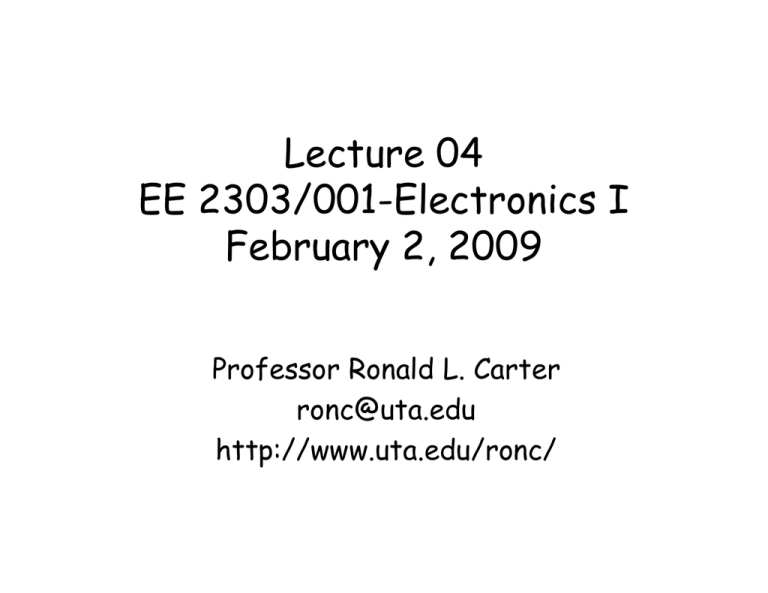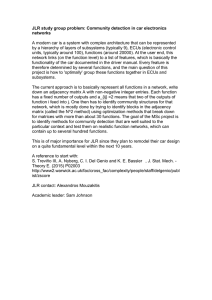Lecture 04 EE 2303/001 Electronics I EE 2303/001
advertisement

Lecture 04 EE 2303/001-Electronics 2303/001 Electronics I February y 2,, 2009 Professor Ronald L. Carter ronc@uta.edu @ d p http://www.uta.edu/ronc/ K Web Key W b Sites Si • Instructor web site http://www.uta.edu/ronc/ • Course web site http://www.uta.edu/ronc/2303/syllabus.htm • The hyperlink for viewing lectures is http://tinyurl com/ee2303echo http://tinyurl.com/ee2303echo • Quiz results will be posted at http://www uta edu/ronc/2303/Q1soln pdf http://www.uta.edu/ronc/2303/Q1soln.pdf L04, 02 Feb 2 Id l Operational Ideal O i lA Amplifier lifi • Infinite input impedance open loop gain for the • Infinite open-loop differential input signal • Zero gain for the common-mode signal • Zero output impedance • Infinite I fi it b bandwidth d idth L04, 02 Feb 3 O Operational i l Summing S i P Point i • The gain and common-mode assumptions p with sufficient feedback present result in the operational summing g point p vdifferential = v+ - v- = 0 v+ = v • Thus the input operationally simulates a virtual short-circuit short circuit L04, 02 Feb 4 Figure g 2.1 Circuit symbol y for the op p amp. p L04, 02 Feb 5 Figure g 2.2 Equivalent q circuit for the ideal op p amp. p AOL is very y large g (approaching infinity). L04, 02 Feb 6 Figure g 2.3 Op-amp p p symbol y showing g power p supplies. pp L04, 02 Feb 7 http://www.national.com/ds/LM/LM741.pdf L04, 02 Feb 8 L04, 02 Feb http://www.national.com/ds/LM/LM741.pdf 9 L04, 02 Feb http://www.national.com/ds/LM/LM741.pdf 10 L04, 02 Feb 11 Schematic L04, 02 Feb 12 Neglecting input - offset, and due to high gain, we have v+ = v− . This has the effect of creating a virtual short - circuit at the input. v− v+ High input impedance gives an nearly open circuit for the input, i− = 0 = i+ Figure 2.5 We make use of the summing-point constraint in the analysis of the inverting amplifier. L04, 02 Feb 13 R2 R2 vo = − vin . Thus an inverting amplifier, Av = − R1 R1 Zin = ? v− v+ Figure 2.5 We make use of the summing-point constraint in the analysis of the inverting amplifier. L04, 02 Feb 14 ⎛ R2 R4 R4 R2 ⎞ ⎟⎟ + vo = −vin ⎜⎜ + ⎝ R1 R1 R1 R3 ⎠ Note that i1 = i2 i4 = i2 + i3 Figure 2.6 An inverting amplifier that achieves high gain with a smaller range of resistor values than required for the basic inverter. L04, 02 Feb 15 vo = −va Rf Ra − vb Rf Rb Rin ,a = Ra Rin ,b = Rb Ro = 0 L04, 02 Feb Figure 2.7 Summing amplifier. See Exercise 2.1. 16 For the condition V−supply < AOL vi < V+supply V−supply V+supply vo v = − i , requiring < vi < ≈ 5μV AOL R R AOL Either noise, or offset So for current will violate this So, highly specific condition. Thus the internal OA f db k is b feedback broken k and d th the Summing Point (or Virtual Ground) rule no longer holds. L04, 02 Feb vi > vo,max , vo = vo,max ~ V+supply vi < vo,min , vo = vo,min ~ V−supply Figure 2.10a Schmitt trigger circuit and waveforms. 17 t = t1+ε t=0 t = t1-ε L04, 02 Feb Figure 2.10b Schmitt trigger circuit and waveforms. 18 In order for vi to be = 0, we must have R1 vo = vs R1 + R2 vo R1 + R2 = vs R1 L04, 02 Feb Figure 2.11 Noninverting amplifier. 19 L04, 02 Feb Figure 2.12 Voltage follower. 20 L04, 02 Feb Figure 2.14 Differential amplifier. See Exercise 2.5. 21 Figure g 2.13 Inverting g or noninverting g amplifier. p See Exercise 2.4. L04, 02 Feb 22 R i Resistors • Integrated Circuit Resistors • Discrete Resistors L04, 02 Feb 23 Figure 2.16 IC resistors are fabricated from a layer of conductive material. L04, 02 Feb 24 Figure 2.17 The resistance of the larger square is the same as the resistance of each of the smaller squares. L/W = 3, R = 3R Figure 2.18 A resistor having L/W = 3. L04, 02 Feb 25 Figure 2.19 IC resistors are often folded to keep the distance between the contacts smaller. R = Nstraight •R + Ncorner •Rcorner + 2•Rcontact 10 < R < 1000, approximately L04, 02 Feb 26 From Vishay Resistor Manual L04, 02 Feb 27 L04, 02 Feb http://www.uoguelph.ca/~antoon/gadgets/resistors/resistor.htm 28 10% L04, 02 Feb 20% http://www.uoguelph.ca/~antoon/gadgets/resistors/resistor.htm 29 From Ohmcraft Manual L04, 02 Feb 30 Figure 2.20 If low-value resistors are used, an impractically large current is required. L04, 02 Feb 31 Figure 2 2.21 21 If very high value resistors are used used, stray capacitance can couple unwanted signals into the circuit. L04, 02 Feb 32 Figure 2.22 To attain large input resistance with moderate resistances for an inverting amplifier, we cascade a voltage follower with an inverter. L04, 02 Feb 33 R = Nstraight •R + Ncorner •Rcorner + 2•Rcontact Nstraight = 19, Ncorner = 2, Ncontact = 2 R = 100 Ω, Rcorner = 56 Ω, Rcontact = 65 Ω Rtotal = 1,642 Ω Figure 2.24 Resistor for Exercises 2.8. L04, 02 Feb 34 vo = R2 R f R1 RA v1 − Rf RB v2 Figure 2.23 Amplifier designed in Example 2.4. L04, 02 Feb 35 Effect of Finite Gain AOL ( f ) = A0OL 1 + j ( f f BOL ) f t = A0OL f BOL = unity gain frequency A0OL = low frequency gain f BOL = frequency f off gain i break b k - point i Figure 2.25 Bode plot of open-loop gain for a typical op amp. L04, 02 Feb 36 ACL = β= AOL , the closed - loop gain 1 + β AOL R1 R1 + R2 ACL ( f ) = A0CL , where f BCL = f BOL (1 + β A0OL ) 1 + j ( f f BCL ) Figure 2.26 Noninverting amplifier. L04, 02 Feb 37 L04, 02 Feb Figure 2.27 Bode plots for Example 2.5. 38 References and Endnotes • Where not otherwise noted, Figures are taken from: – Electronics, 2nd edition, by Allan R. Hambley, y Prentice Hall, Upper pp Saddle River, NJ, © 2000. L04, 02 Feb 39





